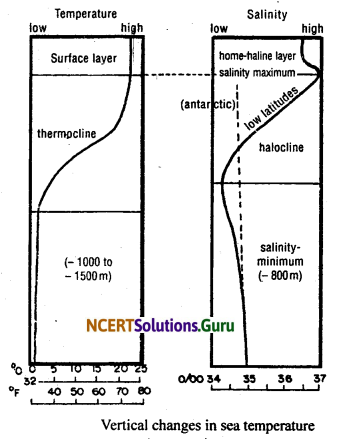Detailed, Step-by-Step NCERT Solutions for Class 11 Geography Chapter 13 Water (Oceans) Questions and Answers were solved by Expert Teachers as per NCERT (CBSE) Book guidelines covering each topic in chapter to ensure complete preparation.
Water (Oceans) NCERT Solutions for Class 11 Geography Chapter 13
Water (Oceans) Questions and Answers Class 11 Geography Chapter 13
Question 1.
Multiple Choice Questions :
(i) Multiple Choice Questions:
(1) Identify the element which is not a part of the hydro logical cycle.
(a) Evaporation
(b) Hydration
(c) Precipitation
(d) Condensation
Answer:
(b) Hydration.
(ii) The average depth of continental slope varies between
(a) 2-20 m.
(b) 200-2,000 m.
(c) 20-200 m.
(d) 2,000-20,000 m.
Answer:
(b) 200-2,000 m.
![]()
(iii) Which one of the following is not a minor relief feature in the oceans?
(a) Seamount
(b) Oceanic Deep
(c) Atoll
(d) Guyot
Answer:
(c) Atoll.
(iv) Salinity is expressed as the amount of salt in grams dissolved jn sea water :
(a) 10 gm.
(b) 1,000 gm.
(c) 100 gm.
(d) 10,000 gm.
Answer:
(b) 1,000 gm.
(v) Which one of the following is the smallest ocean?
(a) Indian Ocean
(b) Arctic Ocean
(c) Atlantic Ocean
(d) Pacific Ocean
Answer:
(a) Indian Ocean.
Question 2.
Answer the following questions in about 30 words each :
(i) Why do we call the earth a Blue planet?
Answer:
Because of abundance of water on its surface, the earth is often called a Blue planet.
(ii) What is a continental margin?
Answer:
Continental margins are the relief features of the earth. They consist of two major submarine features, the continental shelf and continental slope.
![]()
The continental shelf fringes the continents in width from a few km. to 300 km. The slope abruptly is replaced by the continental rise.
(iii) List out the deepest trenches of various oceans.
| Ocean | Trench |
| Pacific | Marina, Mindano, Bonin, Japan, Aluetian, Tonga, Kermodec, Atacama |
| Indian | Sunda |
| Atlantic | – Puerto Rico – South sandwich – Cayman |
(iv) What is a thermocline?
Answer:
The temperature-depth profile for ocean water shows how temperature decreases with increasing depth. The profile shows a boundary region between surface waters of the ocean and deeper layers. This boundary region, where there is a rapid decrease of temperature, is called the thermocline.

(v) When you move into the ocean, what thermal layers would you encounter? Why the temperature varies with depth?
Answer:
As we move into the ocean, we would encounter three layers from surface to the bottom. The temperature varies with depth. Latitude, unequal distribution of land and water affects the distribution of temperature. Temperature decreases with depth because sun’s rays become more and more slanting and thus the amount of insolation decreases polewards.
(vi) What is salinity of sea water?
Answer:
Salinity is the total amount of dissolved salts in sea water. It is calculated as the amount of salt dissolved in 1000 gms of sea water.
Question 3.
Answer the following questions in about 150 words each :
(i) How are various elements of hydrological cycle interrelated?
Answer:
Hydrological cycle is one of the most fundamental cycles that maintains life on earth. The hydrological cycle depends basically on the interrelationship between the circulation of ocean water and that of the atmosphefe. The interrelationship between these elements is a very complex process.
Water withdrawn from the oceans into the atmosphere by process of evaporation depends on air and sea temperatures and on wind strength and humidity. Another relationship between ocean and hydrological cycle is raising up minute particles of salt and other minerals from the sea.
The salt returns to the oceans through rainfall, rivers and other phases of the hydrological cycle. Hydrological cycle is concerned with water in all its forms, i.e., solid (ice), liquid (water) and gas (water vapour). The interaction between ocean and atmosphere involves all the three states of water – solid, liquid and gaseous.
![]()
(ii) Examine the factors that influence the temperature distribution of the oceans.
Answer:
The major source of temperature of the oceanic water is the sun. The various factors which affect the distribution of temperature of the ocean water include ‘attitude, unequal distribution of land and water, prevailing wind, ocean currents, and minor factors like submarine ridges, local weather condition and shape and size of the sea. On an average, the temperature of the surface water of the oceans is 26.7°C. It decreases gradually from equator to the poles.